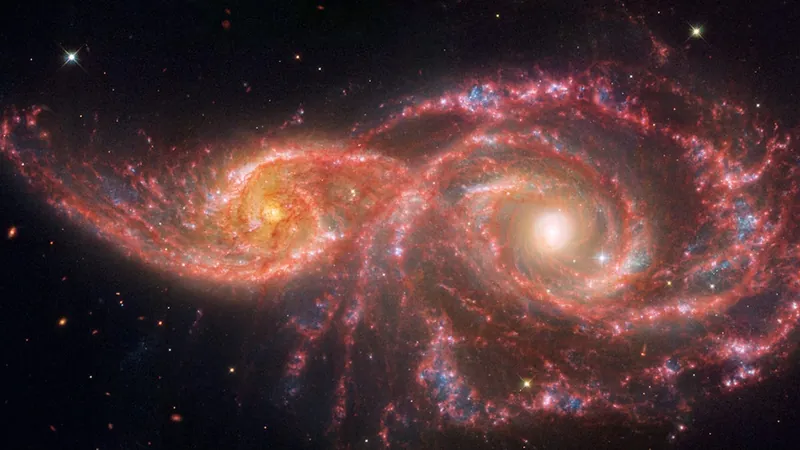
Stunning NASA Footage Reveals 'Blood-Soaked Eyes' of Two Galaxies in Cosmic Collision!
2024-11-06
Author: Wai
Stunning NASA Footage Reveals 'Blood-Soaked Eyes' of Two Galaxies in Cosmic Collision!
In a breathtaking display of cosmic phenomena, NASA has unveiled captivating footage of two galaxies, IC 2163 and NGC 2207, which are approximately 80 million light-years away from Earth. These galaxies have garnered the chilling nickname "blood-soaked eyes" thanks to the remarkable visuals captured by the Hubble and James Webb Space Telescopes.
The striking imagery depicts how these galaxies are gravitationally interacting, with their distinct features drawing comparisons to an eerie face. NASA's press release describes them as having "the long, ghastly 'stare' of their searing eye-like cores shining out into the supreme cosmic darkness." This unique observation contributes significantly to our understanding of how galaxy collisions can trigger rapid star formation.
A Closer Look at IC 2163 and NGC 2207
IC 2163, the smaller of the two, measures around 101,000 light-years in diameter, remarkably similar in size to our own Milky Way galaxy. On the other hand, NGC 2207 is larger, stretching about 143,000 light-years across. Despite the apparent imminent collision portrayed in the video, NASA clarifies that these galaxies have merely grazed each other as they swing gracefully through the cosmos.
This extraordinary cosmic dance is a slow process, unfolding over millions of years. As the two galaxies interact, they will continue to influence each other's shapes, with the potential to eventually form a singular, brilliant "cyclops eye" at their core. NASA highlighted that "over many millions of years, the galaxies may swing by one another repeatedly," leading to reshaped arms and an intensified central core.
The images not only serve as a visual feast but also as a powerful reminder of the dynamic and ever-changing nature of our universe. The observations from advanced telescopes like Hubble and James Webb provide critical insights into galaxy formation and evolution, helping astronomers unlock the mysteries of the cosmos.
Stay tuned for more updates as we continue to explore the wonders of space and uncover the secrets hidden among the stars!


 Brasil (PT)
Brasil (PT)
 Canada (EN)
Canada (EN)
 Chile (ES)
Chile (ES)
 España (ES)
España (ES)
 France (FR)
France (FR)
 Hong Kong (EN)
Hong Kong (EN)
 Italia (IT)
Italia (IT)
 日本 (JA)
日本 (JA)
 Magyarország (HU)
Magyarország (HU)
 Norge (NO)
Norge (NO)
 Polska (PL)
Polska (PL)
 Schweiz (DE)
Schweiz (DE)
 Singapore (EN)
Singapore (EN)
 Sverige (SV)
Sverige (SV)
 Suomi (FI)
Suomi (FI)
 Türkiye (TR)
Türkiye (TR)